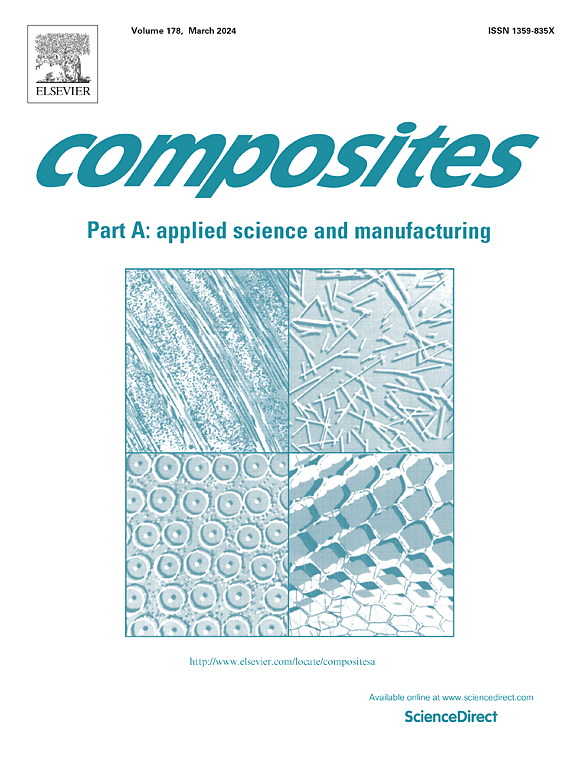聚合物浸润和热解后挤压成型碳/碳复合材料的各向同性弹性常数和拉伸强度
IF 8.1
2区 材料科学
Q1 ENGINEERING, MANUFACTURING
Composites Part A: Applied Science and Manufacturing
Pub Date : 2025-03-24
DOI:10.1016/j.compositesa.2025.108884
引用次数: 0
摘要
本文章由计算机程序翻译,如有差异,请以英文原文为准。
Orthotropic elastic constants and tensile strength of extrusion-based additively manufactured carbon/carbon composites after polymer infiltration and pyrolysis
This study was aimed at obtaining orthotropic elastic constants and tensile strengths of extrusion-based additively manufactured (EDAM) carbon/carbon (C/C) composites. Micro-computed tomography (µCT) data was coupled with impulse excitation data and Mori-Tanaka homogenization- based microstructural modeling to analyze 50 wt% short carbon fiber-loaded polyphenylene sulfide (PPS)-based C/C composites. After five polymer infiltration and pyrolysis cycles, the elastic constants and average tensile strength were found to be E1 = 30.48 GPa, E2 = 17.85 GPa, E3 = 12.34 GPa, G23 = 5.57 GPa, G13 = 6.65 GPa, G12 = 9.19 GPa, ν23 = 0.28, ν13 = 0.25, ν12 = 0.26, and σT = 12.71 MPa, respectively. The results were unique to the fiber orientation induced during 3D printing and pore volume fraction achieved with densification and highlights the Mori-Tanaka- based microstructural modeling as a beneficial tool for capturing the fiber architecture- and process- dependent behavior of C/C composites.
求助全文
通过发布文献求助,成功后即可免费获取论文全文。
去求助
来源期刊

Composites Part A: Applied Science and Manufacturing
工程技术-材料科学:复合
CiteScore
15.20
自引率
5.70%
发文量
492
审稿时长
30 days
期刊介绍:
Composites Part A: Applied Science and Manufacturing is a comprehensive journal that publishes original research papers, review articles, case studies, short communications, and letters covering various aspects of composite materials science and technology. This includes fibrous and particulate reinforcements in polymeric, metallic, and ceramic matrices, as well as 'natural' composites like wood and biological materials. The journal addresses topics such as properties, design, and manufacture of reinforcing fibers and particles, novel architectures and concepts, multifunctional composites, advancements in fabrication and processing, manufacturing science, process modeling, experimental mechanics, microstructural characterization, interfaces, prediction and measurement of mechanical, physical, and chemical behavior, and performance in service. Additionally, articles on economic and commercial aspects, design, and case studies are welcomed. All submissions undergo rigorous peer review to ensure they contribute significantly and innovatively, maintaining high standards for content and presentation. The editorial team aims to expedite the review process for prompt publication.
 求助内容:
求助内容: 应助结果提醒方式:
应助结果提醒方式:


